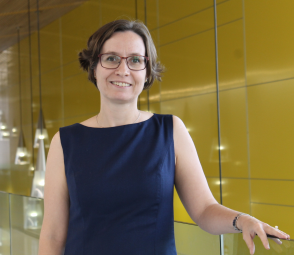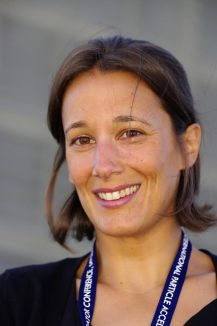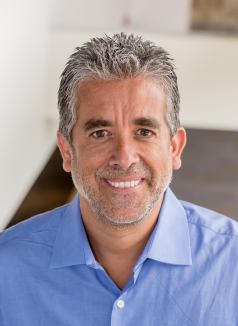Below you can find some short bios of women and men who are part of the women in plasma physics committee of the American Physical Society – Division of Plasma Physics. Membership changes over the years and the goal is to have a balance between universities and laboratories, the different sub-fields and career stage.
Stephanie Hansen (chair)
Stephanie Hansen is a Distinguished Member of the Technical Staff in the ICF target design group at Sandia National Laboratories, where she develops atomic, spectroscopic, equation-of-state, and transport models to help predict and diagnose the behavior of high energy-density plasmas. In 2014 she was awarded a five-year Early Career grant from the Department of Energy’s Office of Fusion Energy Sciences to study the atomic-scale behavior of materials at extreme conditions. She joined Sandia after several years as a staff scientist at Lawrence Livermore National Laboratory, holds degrees in both physics and philosophy from the University of Nevada, Reno, and has two children.
Saskia Mordijck (vice chair)
 Saskia Mordijck is an Assistant Professor at the College of William and Mary in Virginia. She received her Master in Engineering (2006) from the KULeuven in Belgium and her Ph.D from University of California San Diego in 2011. She joined W&M first as a research professor in the computer science department and became a tenure track faculty member in 2016. Her research is on transport in Magnetically Confined Plasmas and includes experiment, theory and modeling. She is currently a member of the ITPA, the USBPO and also a member of the Executive Committee of the APS Division of Plasma Physics. When she is not working, she likes to go for a run, hike or discover the world with her boys.
Saskia Mordijck is an Assistant Professor at the College of William and Mary in Virginia. She received her Master in Engineering (2006) from the KULeuven in Belgium and her Ph.D from University of California San Diego in 2011. She joined W&M first as a research professor in the computer science department and became a tenure track faculty member in 2016. Her research is on transport in Magnetically Confined Plasmas and includes experiment, theory and modeling. She is currently a member of the ITPA, the USBPO and also a member of the Executive Committee of the APS Division of Plasma Physics. When she is not working, she likes to go for a run, hike or discover the world with her boys.
Lorin Matthews (former chair)

Lorin Matthews graduated from Baylor University with a B.S. and Ph.D. in Physics in 1994 and 1998, respectively. She worked for Raytheon Aircraft Integration Systems from 1998-2000 as a multi-disciplined engineer in the Flight Sciences Department, where she was the lead vibroacoustics analyst on projects such as NASA’s SOFIA (Stratospheric Observatory for Infrared Astronomy) aircraft. In 2000, she joined the faculty at Baylor University where she is now a Professor in the Department of Physics and Associate Director of CASPER, the Center for Astrophysics, Space Physics, and Engineering Research. Her areas of research include numerical modeling and experimental investigations of the charging and dynamics of dust in astrophysical and laboratory plasma environments, including processes which influence the early stages of planet formation in protoplanetary disks, the evolution of dusty structures in planetary rings, and dynamics, stability, and phase transitions in self-assembling systems such as dust crystals and dust strings. She is currently a member of the Executive Committee of the APS Division of Plasma Physics and Chair of the Committee on Women in Plasma Physics. She lives in a renovated 120-year old department store with her husband and four children.
Felicie Albert
 Félicie Albert is a scientist at the Lawrence Livermore National Laboratory, USA, which she joined as a postdoctoral researcher in 2008, and as a staff scientist in 2010 in the National Ignition Facility (NIF) and Photon Science directorate. She earned her PhD in physics in 2007 from the Ecole Polytechnique in France, her MS in Optics from the University of Central Florida in 2004, and her BS in engineering from the Ecole Nationale Supérieure de Physique de Marseille, France, in 2003. Her research is on the generation of novel sources of electrons, x-rays and gamma-rays through laser-plasma interaction, laser-wakefield acceleration, and Compton scattering. She has conducted many experiments using high-intensity lasers, including NIF, LLNL’s Jupiter Laser Facility, OMEGA-EP, and Stanford’s Linac Coherent Light Source x-ray free electron laser. She is the recipient of a 2016 U.S. Department of Energy Early Career Research Program Award, and has been leading several Laboratory Directed Research and Development Projects at LLNL. She is also the recipient of the 2017 Katherine E. Weimer award from the American Physical Society for outstanding achievements in plasma science research, and was selected by the APS as an outstanding referee in 2015. She lives in the San Francisco Bay Area with her husband, and when not at work, she enjoys outdoor activities in the mountains or the ocean, and being in France with her family.
Félicie Albert is a scientist at the Lawrence Livermore National Laboratory, USA, which she joined as a postdoctoral researcher in 2008, and as a staff scientist in 2010 in the National Ignition Facility (NIF) and Photon Science directorate. She earned her PhD in physics in 2007 from the Ecole Polytechnique in France, her MS in Optics from the University of Central Florida in 2004, and her BS in engineering from the Ecole Nationale Supérieure de Physique de Marseille, France, in 2003. Her research is on the generation of novel sources of electrons, x-rays and gamma-rays through laser-plasma interaction, laser-wakefield acceleration, and Compton scattering. She has conducted many experiments using high-intensity lasers, including NIF, LLNL’s Jupiter Laser Facility, OMEGA-EP, and Stanford’s Linac Coherent Light Source x-ray free electron laser. She is the recipient of a 2016 U.S. Department of Energy Early Career Research Program Award, and has been leading several Laboratory Directed Research and Development Projects at LLNL. She is also the recipient of the 2017 Katherine E. Weimer award from the American Physical Society for outstanding achievements in plasma science research, and was selected by the APS as an outstanding referee in 2015. She lives in the San Francisco Bay Area with her husband, and when not at work, she enjoys outdoor activities in the mountains or the ocean, and being in France with her family.
Elizabeth Merritt
Dr. Elizabeth Merritt is currently a staff Scientist in the Plasma Physics group (P-24) at Los Alamos National Laboratories where she specializes in experimental high-energy-density (HED) plasma physics and inertial-confinement fusion (ICF). For her undergraduate education Dr. Merritt received a B.A. in math and physics from Mount Holyoke College, with a concentration in optoelectronic for telecommunications. She received her Ph.D. in physics from the University of New Mexico in 2013 for work on rail-gun generated plasma jets done in collaboration with Los Alamos National Lab, where she remained for her postdoctoral work as well. Currently her work includes studies of hydrodynamic instabilities and turbulence under HED conditions, equation-of-state experiments, and development of inertial-confinement fusion platforms on large laser facilities like OMEGA, Omega EP, and the NIF.
Luis Felipe Delgado-Aparicio Villaran
 A native of Lima-Peru, Luis Felipe Delgado-Aparicio Villaran earned a bachelor and licentiate degrees in physics from the Pontificia Universidad Catolica del Peru in 1997, and a master’s degree in Astrophysics from Princeton University in 2001. He obtained a second master’s in physics from The Johns Hopkins University (JHU) and received his PhD in physics also from JHU in 2007. Most of his experimental diagnostic and nuclear fusion work was carried out at the NSTX reactor at the Princeton Plasma Physics Laboratory (PPPL). Luis Felipe became a scientist at JHU right away, but was soon recruited by Princeton University in 2009 to spent four years as a visiting scientist at The Plasma Science and Fusion Center (PSFC) at the Massachusetts Institute of Technology (MIT) in Cambridge, MA. Since his return to Princeton in 2013, Luis Felipe has won few awards in plasma physics and nuclear fusion including the Department of Energy (DOE) Early Career Award in 2015, the General Atomics Torkil Jensen Award in 2016, the President’s International Fellowship Initiative (PIFI) award from the Chinese Academy of Sciences (CAS) in 2018 and a Measurement Innovation Award from DOE also in 2018. Luis Felipe has lead experiments at the four major fusion experiments in the USA (NSTX, C-Mod, DIII-D and MST), and designs and builds nuclear fusion diagnostics for universities and national laboratories in the USA, China, France, Japan, and the international community at ITER. He has written and published more than 140 scientific articles having more than 1700 citations. Luis Felipe lives in Princeton, NJ with his family.
A native of Lima-Peru, Luis Felipe Delgado-Aparicio Villaran earned a bachelor and licentiate degrees in physics from the Pontificia Universidad Catolica del Peru in 1997, and a master’s degree in Astrophysics from Princeton University in 2001. He obtained a second master’s in physics from The Johns Hopkins University (JHU) and received his PhD in physics also from JHU in 2007. Most of his experimental diagnostic and nuclear fusion work was carried out at the NSTX reactor at the Princeton Plasma Physics Laboratory (PPPL). Luis Felipe became a scientist at JHU right away, but was soon recruited by Princeton University in 2009 to spent four years as a visiting scientist at The Plasma Science and Fusion Center (PSFC) at the Massachusetts Institute of Technology (MIT) in Cambridge, MA. Since his return to Princeton in 2013, Luis Felipe has won few awards in plasma physics and nuclear fusion including the Department of Energy (DOE) Early Career Award in 2015, the General Atomics Torkil Jensen Award in 2016, the President’s International Fellowship Initiative (PIFI) award from the Chinese Academy of Sciences (CAS) in 2018 and a Measurement Innovation Award from DOE also in 2018. Luis Felipe has lead experiments at the four major fusion experiments in the USA (NSTX, C-Mod, DIII-D and MST), and designs and builds nuclear fusion diagnostics for universities and national laboratories in the USA, China, France, Japan, and the international community at ITER. He has written and published more than 140 scientific articles having more than 1700 citations. Luis Felipe lives in Princeton, NJ with his family.
Maria Gatu Johnson
 Dr. Gatu Johnson is a research scientist in the High Energy Density (HED) physics group at the MIT Plasma Science and Fusion Center. She divides her time between programmatic Inertial Confinement Fusion (ICF) research, astrophysically-relevant nuclear science experiments using the ICF/HED platform at the OMEGA and NIF laser facilities, and managing the MIT HED accelerator for nuclear diagnostic development. Dr. Gatu Johnson received her PhD in Applied Nuclear Physics from Uppsala University, Sweden, in 2010, working on neutron diagnostics for the JET tokamak. In addition to the WIPP, she also serves on the OLUG executive committee and the HEDSA steering committee.
Dr. Gatu Johnson is a research scientist in the High Energy Density (HED) physics group at the MIT Plasma Science and Fusion Center. She divides her time between programmatic Inertial Confinement Fusion (ICF) research, astrophysically-relevant nuclear science experiments using the ICF/HED platform at the OMEGA and NIF laser facilities, and managing the MIT HED accelerator for nuclear diagnostic development. Dr. Gatu Johnson received her PhD in Applied Nuclear Physics from Uppsala University, Sweden, in 2010, working on neutron diagnostics for the JET tokamak. In addition to the WIPP, she also serves on the OLUG executive committee and the HEDSA steering committee.
Paul Keiter (former member)
Paul Keiter is an Associate Research Scientist in the Center for Laser Experimental Astrophysics Research at the University of Michigan. His research is focused on studying physics of interest in astrophysical systems with high-energy-density physics. Topics of research include radiation hydrodynamics and spectroscopy. When not working, he is kept busy by his two daughters.
Arati Dasgupta (former member)
 Arati Dasgupta is the head of the Atomic Physics and Ionization Kinetics Section in the Radiation Hydrodynamics Branch of the Plasma Physics Division at the Naval research Laboratory (NRL). Presently she works on non-local thermodynamic equilibrium atomic and plasma modeling and simulation of High Energy Density (HED) plasma experiments, such as the Sandia National Laboratories multi-keV Z-pinch plasma radiation sources, various high atomic number (ZA) radiation sources at the National Ignition Facility, and radiation physics for high ZA elements on the NRL NIKE laser in support of ICF. Her interdisciplinary atomic and plasma physics research spans pulsed power radiation sources, inertial confinement fusion (ICF), laser-matter interaction, astrophysics and lighting. She is a member of several science panels, reviewer of several award selection committees including DOE’s E.O. Lawrence award and serve on several advisory committees including DOE’s Fusion Energy Sciences Advisory Committee (FESAC). She is an executive member of the IEEE Plasma Science Applications Committee (PSAC). She is a Fellow of the American Physical Society, Fellow of the Washington Academy of Sciences, has served on several education and program committees of the APS Divisions of Atomic, Molecular and Optical Physics and Plasma Physics, chaired Women in Plasma Physics Committee of the APS/DPP (2013-2015), and chaired the Women in Science and Engineering Committee at NRL (2008-2012). She has provided an essay on invitation to the book “Blazing the Trail: Essays by Leading Women in Science” to inspire young women to pursue career in science. Recently (2016) she presented a public lecture at the University of Wisconsin – La Crosse as part of their yearly Public Lecture Series featuring prominent women in physics, astronomy, and engineering.
Arati Dasgupta is the head of the Atomic Physics and Ionization Kinetics Section in the Radiation Hydrodynamics Branch of the Plasma Physics Division at the Naval research Laboratory (NRL). Presently she works on non-local thermodynamic equilibrium atomic and plasma modeling and simulation of High Energy Density (HED) plasma experiments, such as the Sandia National Laboratories multi-keV Z-pinch plasma radiation sources, various high atomic number (ZA) radiation sources at the National Ignition Facility, and radiation physics for high ZA elements on the NRL NIKE laser in support of ICF. Her interdisciplinary atomic and plasma physics research spans pulsed power radiation sources, inertial confinement fusion (ICF), laser-matter interaction, astrophysics and lighting. She is a member of several science panels, reviewer of several award selection committees including DOE’s E.O. Lawrence award and serve on several advisory committees including DOE’s Fusion Energy Sciences Advisory Committee (FESAC). She is an executive member of the IEEE Plasma Science Applications Committee (PSAC). She is a Fellow of the American Physical Society, Fellow of the Washington Academy of Sciences, has served on several education and program committees of the APS Divisions of Atomic, Molecular and Optical Physics and Plasma Physics, chaired Women in Plasma Physics Committee of the APS/DPP (2013-2015), and chaired the Women in Science and Engineering Committee at NRL (2008-2012). She has provided an essay on invitation to the book “Blazing the Trail: Essays by Leading Women in Science” to inspire young women to pursue career in science. Recently (2016) she presented a public lecture at the University of Wisconsin – La Crosse as part of their yearly Public Lecture Series featuring prominent women in physics, astronomy, and engineering.